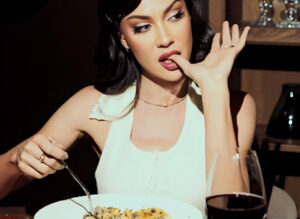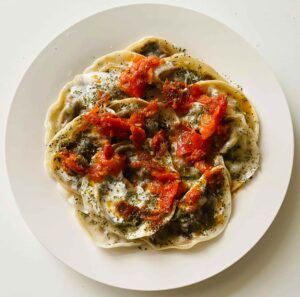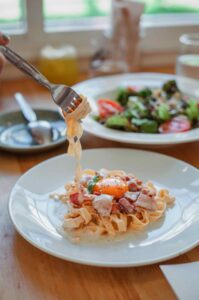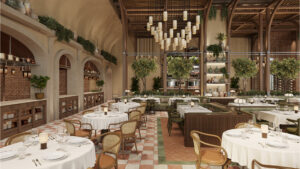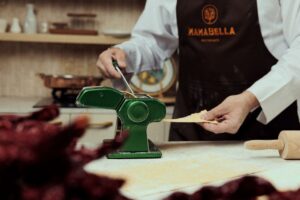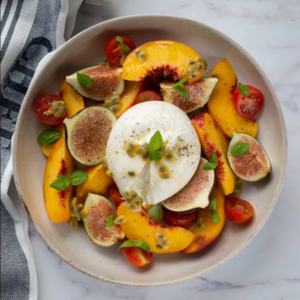Sardinian vs Mainland Italian cuisine isn’t just a matter of regional pride—it’s a delicious lesson in geography, heritage, and technique. As Mama Bella prepares to open its doors at Kempinski, The Boulevard in Dubai, our culinary team is shaping a menu that celebrates Sardinia’s unique soul while helping guests understand how it differs from the broader traditions of mainland Italy. From ancient breads and sheep’s milk cheeses to seafood-forward pastas and wood-fired specialties, Sardinian food brings a distinctive Mediterranean character that stands apart from the peninsula’s diverse regional kitchens. If you’re seeking an Italian restaurant in Dubai with genuine island roots, our pre-launch concept sets the table for a rich comparison—one that’s as informative as it is satisfying.
Sardinia’s Island Identity vs. Italy’s Regional Mosaic
Italy’s mainland is a tapestry of regions—Piedmont, Tuscany, Lazio, Puglia, and more—each with its own pantry and palate. Sardinia, by contrast, is an island whose culinary traditions evolved through relative isolation, pastoral life, and maritime trade. This separation helped preserve flavors that feel ancient yet vibrant: earthy, herb-driven meats; seafood seasoned with citrus and bottarga; and breads that are as much ritual as sustenance. The result? Sardinian cuisine tends to be leaner on dairy-heavy sauces and tomato-forward combinations than many mainland staples, leaning instead into olive oil, herbs like myrtle and wild fennel, and the briny kiss of the sea.
Signature Ingredients You’ll Taste in Sardinia
Pecorino Sardo: While mainland Italy uses a spectrum of cow’s, sheep’s, and goat’s cheeses, Sardinia is synonymous with sheep’s milk cheese. Pecorino Sardo ranges from young and soft to mature and robust, adding depth to pasta, salads, and antipasti. Its savory intensity contrasts beautifully with honey or citrus zest, a pairing that feels quintessentially Mediterranean.
Bottarga: Cured mullet roe, shaved or grated, is Sardinia’s “truffle of the sea.” Where mainland sauces might rely on slow-simmered tomatoes or butter and Parmigiano, Sardinian pasta often turns to bottarga for umami richness, balanced by lemon, garlic, and excellent olive oil. A simple spaghetti with bottarga and lemon shows how restraint can be powerful.
Pane Carasau: This paper-thin, twice-baked flatbread is both a daily bread and a canvas. Unlike many mainland loaves with soft crumb and thick crusts, pane carasau offers a delicate crunch, layered with fresh cheeses, olive oil, and preserved vegetables—or softened with broth to create “pane frattau,” a savory lasagna-like dish topped with tomato and a soft egg.
Myrtle & Wild Fennel: On the island, aromatics are not background notes; they are leading actors. Myrtle (mirto) perfumes roasts and infusions, while wild fennel brightens seafood and grains, distinguishing Sardinian dishes from the basil-forward profiles often associated with parts of the mainland.
Pasta Traditions: Handcrafted Forms vs. Mainland Varieties
Italy’s mainland gave the world an immense pasta repertoire—spaghetti, tagliatelle, orecchiette, and beyond. Sardinia, meanwhile, preserves shapes deeply tied to its landscape and festivals. At Mama Bella, our menu planning highlights these forms to honor the island’s heritage:
Malloreddus (Sardinian gnocchi)
Made from semolina and water, these ridged shells excel at catching sauces. While mainland classics might feature ragùs simmered with beef or pork, Sardinian preparations often lean on fennel sausage, saffron, and light tomato bases that emphasize spice and aroma over heaviness.
Culurgiones
These hand-sealed pasta “pouches” are typically filled with potato, pecorino, and mint. The braided closure is as iconic as the filling itself. Mainland stuffed pastas—think ravioli or tortellini—tend to spotlight ricotta, spinach, or meat blends; culurgiones stand out for their herbaceous freshness and the salty tang of sheep’s milk cheese.
Fregola
A toasted semolina pasta reminiscent of couscous, fregola partners beautifully with clams, tomatoes, and saffron. Where mainland Italy might pair small shapes with hearty legumes or butter-based emulsions, Sardinia nudges fregola toward the shoreline, harnessing seafood and shellfish for a clean, briny finish.
If you’re eager for a deep dive into our pasta program as we approach opening, explore our plans for handcrafted pasta in Dubai and see how these Sardinian shapes will feature prominently.
Wood-Fired Expressions: Pizza & Beyond
Wood-fired ovens are beloved across Italy, yet Sardinia’s approach is often lighter and herb-forward, letting the dough’s aroma and the olive oil’s fruitiness shine. Mainland pizza traditions—Naples and Rome especially—are celebrated for their techniques and toppings. Sardinian-inspired pies, by contrast, may highlight pecorino, seasonal greens, artichokes, and cured fish accents used sparingly for a clean, marine dimension. At Mama Bella, our wood-fired philosophy favors restraint and balance, championing ingredients that taste like they were grown under Mediterranean sun and sea breezes. For a preview of our pizza craft, browse our page on wood-fired pizza in Dubai.
Seafood vs. Pasture: Where the Plate Begins
On the mainland, inland regions lean into game, beef, and pork, while coastal zones celebrate fish and shellfish. Sardinia marries both worlds but through its own lens: sheep and goats still shape the dairy and meat pantry, while the surrounding sea offers mullet, clams, octopus, and more. The island’s dishes rarely feel heavy; olive oil, citrus, and herbs keep flavors bright. A lamb stew may appear, but expect it scented with myrtle or wild herbs. A grilled octopus might arrive brushed simply with oil and lemon, letting smoke and brine do the talking.
Breads & Sweets: Ritual and Celebration
Mainland bakeries abound with focaccia, ciabatta, and regional sweet specialties. Sardinia’s breads are often lighter and symbolic—pane carasau for everyday meals and pane guttiau (brushed with oil and salt) as a celebratory snack. On the dessert side, Sardinia’s seadas—a pastry filled with fresh cheese and drizzled with honey—showcases that signature sheep’s milk tang. Where mainland classics such as tiramisù or panna cotta luxuriate in creaminess, seadas strikes a balance of crispy, salty-sweet, and citrusy. Expect honey to be as important as sugar, and citrus zest to brighten every bite.
Wines: Island Sun in the Glass
Italy’s mainland boasts a panorama of DOCG icons; Sardinia contributes distinct expressions shaped by wind, salt, and heat. Vermentino offers citrus and floral lift for seafood, while Cannonau (Grenache) brings warm spice and red fruit for roasted meats and pecorino-rich pastas. Carignano, with its ripe berry notes and gentle tannins, pairs beautifully with fregola and shellfish. At Mama Bella, our developing wine program focuses on Italian bottles with a spotlight on Sardinian varietals, aligning pairings to our menu’s clean, aromatic cooking style. Explore our evolving list through our Italian wine curation in Dubai.
Techniques that Tell a Story
Many mainland sauces develop richness through long cooking or dairy emulsions. Sardinia often seeks clarity: toasting fregola for nutty depth, finishing pasta in olive oil and bottarga, or slow-roasting meats with myrtle and aromatic wood. Even when tomatoes appear, they’re used judiciously to support rather than dominate. The guiding principles are seasonality, simplicity, and respect for the ingredient.
The Mama Bella Approach in Dubai
As Mama Bella moves through its pre-launch phase at Kempinski, The Boulevard, Dubai, we’re crafting an experience that reflects Sardinia’s warmth and conviviality. Expect an elegant yet relaxed room with rustic touches and sun-lit textures, designed for shared plates and family-style dining. Our culinary team handcrafts pasta daily, leans into Mediterranean ingredients, and cooks with live fire to connect food to memory. For a broader look at our concept and story, visit our about page and the dedicated hub for our Sardinian restaurant in Dubai.
Comparing Dishes: Sardinian vs. Mainland Classics
Antipasti
Sardinian starters often highlight preserved vegetables, olives, and pane carasau with fresh cheeses, while mainland antipasti might lean into cured meats, mozzarella, and tomato-led combinations. The island approach feels lighter and crisper, built for leisurely grazing.
Pasta
Culurgiones and malloreddus demonstrate Sardinia’s love for texture and herbs. Mainland Italy showcases regional icons—from ragù alla bolognese to cacio e pepe—yet the Sardinian palate brings a salty-sea accent (bottarga) or pastoral notes (pecorino, mint) you won’t mistake for anything else.
Secondi
Porceddu (roast suckling pig) is a Sardinian celebration dish, perfumed with myrtle and slow-cooked to tenderness. Mainland roasts vary widely—Florentine steak, Roman lamb, Tuscan game—yet the Sardinian table keeps seasonings minimal and aromatics expressive.
Dolci
Seadas with honey delivers a striking contrast of textures and temperatures; on the mainland, tiramisù’s creamy layers or panna cotta’s silkiness tell a different, dairy-forward story.
Dining with Family: Communal, Warm, and Unrushed
Sharing is integral to Sardinian hospitality. At Mama Bella, dishes are designed to pass, taste, and compare, making it easy for families and groups to explore unfamiliar flavors together. Large-format salads, baskets of pane carasau, and a rotation of pasta shapes encourage conversation. Our team will be on hand to explain traditions, suggest pairings, and guide you through the island’s pantry—always with a focus on authenticity and comfort.
Seasonality: The Mediterranean Calendar on a Plate
In Sardinia, the year’s rhythm dictates the menu. Spring may usher in artichokes and tender herbs; summer sings with tomatoes and fragrant citrus; autumn leans on mushrooms and robust greens; winter welcomes slow-braised meats and hearty grains. As we refine Mama Bella’s menu for Dubai, we scale this seasonality to the local market while keeping the spirit intact—bright, fresh, and honest. If you’d like to preview our evolving offerings, keep an eye on our menu as it develops ahead of opening.
How to Experience These Differences in Dubai
If you love exploring regional Italian food, Sardinia offers a rewarding path. Start by tasting side-by-side: try a bottarga-laced pasta next to a tomato-forward mainland classic; compare pane carasau with a pillowy focaccia; sip Vermentino against a northern Italian white. When you’re ready to plan your visit, you can make an enquiry for our pre-launch experiences or future bookings via our reservations page. For broader inspiration, you can also browse insights on our Italian restaurant in Dubai hub.
Quick FAQ
What’s the biggest flavor difference between Sardinian and mainland Italian cuisine?
Sardinia favors clean, herb-led, and seafood-accented flavors (bottarga, myrtle, wild fennel), whereas many mainland regions lean into tomato-based sauces, butter-and-cheese emulsions, or slow-cooked ragùs.
Which pastas best represent Sardinia?
Malloreddus, culurgiones, and fregola. Each showcases texture, restraint, and the island’s signature ingredients like pecorino and saffron.
Is pizza different, too?
Yes. While wood-fired pizza is a national love, Sardinian-leaning pies highlight ingredients like pecorino, seasonal greens, and delicate seafood accents, keeping toppings balanced and aromatic.
What should I drink with Sardinian dishes?
Vermentino for seafood and bottarga-driven pastas; Cannonau for roasted meats and aged pecorino; Carignano for fregola with shellfish. These wines mirror the island’s sunny, coastal character.
Where is Mama Bella located?
We are nestled within Kempinski, The Boulevard in Dubai. As we are in a pre-launch phase, we focus on concept development, seasonal testing, and menu refinement—no pricing or operational specifics yet, just genuine Sardinian inspiration.
In short, Sardinian vs Mainland Italian cuisine comes down to terroir and tradition. At Mama Bella, we preserve the island’s honest flavors—handcrafted pasta, wood-fired cooking, and Mediterranean ingredients—so guests in Dubai can savor the differences one thoughtful bite at a time. For enquiries, collaborations, or private dining interest, reach us via our contact page.

